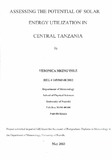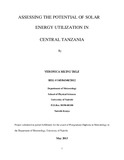| dc.description.abstract | Solar energy is the energy direct from the sun. Central Tanzania is a very vulnerable area in the
face of climate change, already seeing great droughts leading to recurrent hydro-power crisis and
agricultural problems. So through different technologies solar energy can therefore be harnessed
for thermal use and for electrical generation purposes. This technology can be harnessed through
Active_solar techniques_using photovoltaic panels, pumps, and fans to convert sunlight into
useful energy as well as Passive solar techniques which_include selecting materials with
favorable thermal properties, designing spaces that naturally circulate air, and referencing the
position of a building to the sun.
Solar radiation data, sunshine hour's data and cloud amount data for both Dodoma and Tabora
was obtained from Tanzania Meteorological Agency (TMA) and was from 2002 to 2012.
The methodology used in this study included the calculation of missing data by arithmetical
mean method, homogeneity by single mass curve and trend by time series.
The study indicated that solar energy viability is more efficiency from May to Nov, at this period
cloud amount are few, solar radiation is low and sunshine hours are high. During this period
sunshine rays are in high amount and almost found throughout .Residence can turn up on using
this energy since is highly reliable and requires little maintenance. | en_US |


